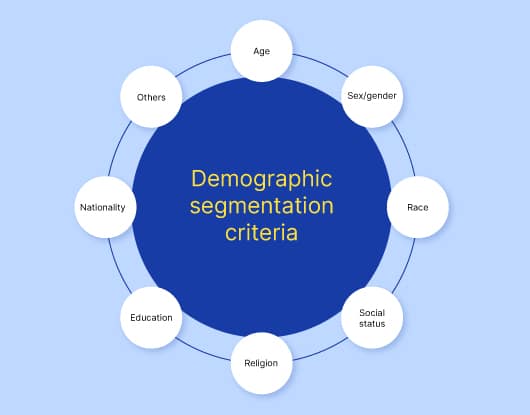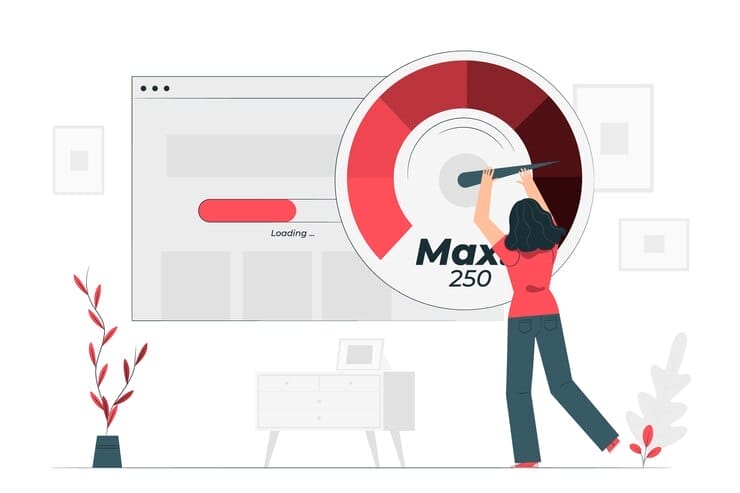With all the noise about market segmentation, one thing is clear; market segmentation is useless to you unless you apply it correctly. Let me explain:
Imagine that as a kids wear brand, you have identified working-class parents aged 24 – 40 living in Texas, US, and married with a kid as your potential market.
How do you group them? What market segmentation type is best? What factor should you consider when grouping?
Done wrongly, the market segmentation will yield no positive results for your brand. It may lead to wastage of resources, as you will keep sending the right message to the wrong person or the wrong message to the right person – talk about pouring water into a basket.
Hence, it is necessary to know the forms of market segmentation, how they work, and which is best for achieving your brand’s marketing goal.

Types of Market Segmentation
There are five known types of market segmentation, and choosing the one(s) ideal for your brand will depend on factors I will tell you about later.
For now, here are the five ways you can segment your market.
Geographical Segmentation – Where?

Imagine selling snowmobiles in a hot country like Mali or bikinis in Antarctica, the coldest country in the world. Preposterous, yes?
Geographical segmentation runs on the idea that location can determine general needs and buying habits, a primarily true belief.
Residents in Mali would probably never need a snowmobile, nor would residents in Antarctica if you ever find someone who needs a bikini.
Geographical segmentation allows businesses to group their target audience based on their location, where they live, work, or occasionally frequent.
Still, using my Mali and Antarctica example, someone in Mali would most likely patronize a swimwear brand more than they would a snowmobile company. Someone staying in Antarctica would probably need a snowmobile more than a bikini.
Beyond segmenting depending on continent or country, geographical segmentation can get as personal as grouping your market based on its neighborhood, district, population density, and even postal code. It can also be contingent on climate, seasons, or the culture of a place.
Take, for instance, a bar opening in the Czech republic. It would be unwise for such a business not to sell beer, which for your information, is reportedly cheaper than water in Czech. (Did you know the average Czech citizen drinks about 160 liters of pure, undiluted alcohol per year?)
Similarly, a bicycle brand launching a branch in a rural area, with mountains, hills, and rocky plains, would need to manufacture strong bicycles with very thick tires if it wants to be patronized by the local outdoor enthusiasts in that area.
However, these features might not be necessary if it was opening in an urban area.
A pizza restaurant in Houston knows better than to target people living in Dallas (both are cities in Texas). A fashion brand based in China knows better than expected sales when it only uses white fabric to make its clothes.
In the first instance, the restaurant’s potential market is more likely to be residents within close distance, as it is rare for anyone to travel down for pizza. Hence, it is customary to see these restaurants hang banners outside their doors and share fliers within the local community.
In the second case, the average Chinese believes that white signifies bad luck, death, or mourning, which is the opposite of what the color means to a westerner.
Both examples are geographical segmentation based on community and culture, respectively.
Typically, geographical segmentation is advisable for a brand with a geographical market, one whose target audience is in a single place.
Demographic Segmentation – Who?

Tagged as one of the simplest among the broad types of market segmentation, demographic segmentation is proof that every product/service meets the needs of select groups of people with similar attributes and that individuals with similar characteristics tend to want the same things.
A good example is a company that only sells sports equipment, pinpointing athletes as its target market, or a high-end brand that produces only luxurious goods highlighting that high-income earners are its audience.
Using information such as age, gender, income, occupation, religion, highest education level attained, and whatnot, demographic segmentation tells a brand which target market.
It helps companies identify and divide their potential market into groups based on this data, allowing them to research each group’s needs, preferences, and buying behavior. Doing this enables such a company to craft sales messages customized to appeal to the tastes of the different groups.
If you have ever wondered why Coca-cola ads never include the elderly, the answer is demographic segmentation based on age.
A cereal brand will not use a teenager to advertise a kids’ cereal, nor will a makeup company use a male model to promote a female makeup product.
As it offers basic information on the ideal market, demographic segmentation helps brands focus their marketing efforts on the right group, thus maximizing limited marketing resources and saving time.
A high-end brand, for instance, would not need to waste its resources marketing to the rich and the not-so-rich. Understanding that only high-income earners can comfortably afford its product, such a brand will customize its sales plan to appeal to this sect.
Compared to other types of segmentation, demographic segmentation data can be acquired easily without seeming intrusive. However, because the customer information it offers is broad, it is typically combined with other types of market segmentation like psychographic segmentation, for instance.
Psychographic Segmentation – Why?

While demographic segmentation answers who is buying, and psychographic segmentation answers why.
Why will a female patronize a particular makeup brand over another?
Is it because of the price or because all her friends use that brand?
Why will college students choose to buy a chill bottle of coke over a cup of orange juice? Is it to relieve academic stress or because of a sweet tooth?
It might seem complicated, but knowing what influences your target market’s consumer behavior will help you correctly present your product/service to them.
I am using the earlier illustration about a luxury brand targeting only high-income earners. Because the phrase “high-income earners” is generic, such a brand may use psychographic segmentation to slim down its market further.
This can involve answering the question; what type of high-income earners are we targeting? Extroverts or introverts? Shopaholics or car enthusiasts? Career women or entrepreneurs?
Answering these questions gives the brand a clear picture of who its target market is and a cue into the kind of persons they are; their personality traits, beliefs, hobbies, etc., all of which influence their buying behavior.
Armed with this information, the brand can break down its market into submarkets and craft marketing plans that depict its product/service in a way that communicates the personality of each group.
So, in this case, a luxury brand targeting extroverted and introverted high-income earners may use commercials that involve many people laughing and having fun to appeal to the extroverts. On the other hand, it may use ads depicting persons enjoying their privacy to appeal to the introverts.
Note that the factors considered under this segmentation are only those that affect the buying behavior of your market and nothing more.
Hence if an introverted segment of your market likes to read books does not affect their buying choices, then it is not a necessary factor to be considered.
By reporting on qualities like personalities, beliefs, attitudes, hobbies, social cycles, lifestyle, values, etc., of a market, psychographic segmentation allows companies to gain an in-depth insight into the inner traits of potential customers.
Behaviorial Segmentation – How?

Grammarly’s “Uh-oh, you might be logged out?” mail is usually sent to users/subscribers who have become infrequent in using the app. However, its “50% off premium plan” mail is sent to frequent users who have not subscribed to its premium version – both are examples of behavior segmentation.
Behavior segmentation attempts to group your market based on their actions when interacting with your product/service. Although similar to psychographic segmentation, behavior segmentation answers HOW your target market buys, not WHY they will buy.
Using the luxury and high-income earners example, after the brand has identified its target market as extroverts and introverts, it can further subdivide the market based on its actions when interacting with the brand.
These actions may include:
– Those who place orders frequently.
– Those who only patronized the brand once and are yet to make another purchase.
– Those who are yet to complete their first purchase.
Using this information, the brand can tailor marketing emails to each group’s peculiarities.
Hence, a loyal customer may get a mail on “specific stocks now available,” a customer who has patronized the brand once can get a “check out what’s new mail,” and one yet to complete their first order can get a “15% discount on your first order” mail.
With technology making living easy, brands can gather the data needed for this market segmentation from the website footprints left by potential markets when interacting with the brands.
The more the data, the better the grouping.
Here are some of the characteristics behavior segmentation covers:
– Product use
– Brand awareness
– Purchase patterns
– Brand loyalty
An advantage of behavior market segmentation is it allows brands to improve their products/services based on customer feedback, thus improving conversion rate and profit.
Firmographic Segmentation – Who?

Firmographic segmentation is similar to demographic, but rather than individuals making up the target market, think companies.
B2B firms use firmographic segmentation, business to business, to identify what their target market looks like.
A company looking to invest in other companies may carry out firmographic market segmentation to know the companies better positioned to receive and maximize their investment.
Carrying out a firmographic segmentation, in this case, would reveal company attributes like:
– Number of employees in the company
– Financial standing of the company
– Growth history
– Type of industry
– Location
– Number of Customers
– Legal status, etc.
Knowing factors such as these will help the investing company pour its investment into the right company. Like demographic segmentation, obtaining data for firmographic segmentation can be done via surveys and market research.
So there you have it, the five main types of market segmentation.
Although there is no hard and fast rule to which type a brand should apply, which style can be used alone, or which can combine with another for best results, experts advise brands to let their products or service affect the market segmentation they choose.
Thus, if a company’s product is contingent on location or climate: lawnmowers or swimwear, for instance, such a brand can apply geographical location to locate its potential customers.
To break down the market, the brand can use demographic segmentation to identify its target audience and group them based on similar characteristics.
Finally, it can apply psychographic segmentation to group them based on why they buy the product.
In this way, the brand can personalize its marketing strategies to communicate effectively to the different groups – talk about effective planning.
Difference Between Market Segmentation and Consumer Segmentation
Although these terms are interchangeable, they are not necessarily the same, though in most cases, they have the same marketing goal – to increase sales and make more profit.
However, while market segmentation is potential grouping customers into segments based on similar characteristics and attributes, customer segmentation is grouping customers you already have into groups based on factors like the value/profit they bring into the business or their needs.
In both cases, the end goal is the same – group the market to create customized marketing plans that will communicate effectively to each group’s needs/ preferences.
Like market segmentation, categorizing your existing customer base can be done using their location, demographics, psychographics, and behaviors, all derivable from the data collected from customers’ past interactions with the product/service in question.
Conclusion
Coined in 1956 by Wendell R. Smith in “Product Differentiation and Market Segmentation as Alternative Marketing Strategies,” market segmentation is recognized by many as vital to any company looking to maximize limited marketing resources fully and increase its conversion rate, ultimately make more profit.
However, companies must know which type of market segmentation to apply beyond merely recognizing its role in achieving the best marketing results.
READ ALSO: Go-to-marketing Strategy (GTM)
You love this Article, right? Get more Updates via Adilo’s Twitter Page.
https://www.efficy.com/market-segmentation/
https://www.voxco.com/blog/what-is-demographic-segmentation/
https://www.formpl.us/resources/market-segmentation/psychographic/
https://www.sender.net/behavioral-segmentation/
https://ninetailed.io/blog/simple-firmographic-segmentation-strategies/








